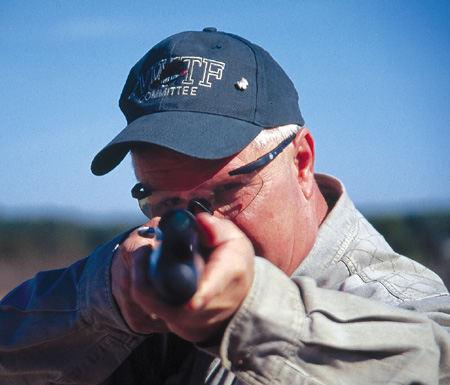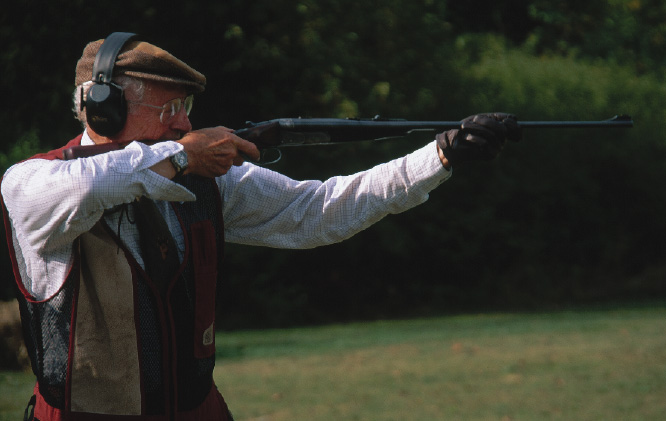
Wingshooting is an eye/hand coordination game. The eyes see the target and send information about the target to the brain. The brain then signals the finger to pull the trigger once the desired lead picture is confirmed. This process sounds easy, and it is when the pieces of the puzzle fall into place. So let’s get right to those pieces of the puzzle.
Once a shooter learns to use his vision to see the target, he must have a working knowledge and understanding of the physical movement required to place the muzzle of his shotgun in a location relative to that moving target. When the muzzle of the gun is pushed to the right spot, the pellets from the fired shotshell will impact the intended target.

He must take into consideration that he is sending a speeding shot charge traveling somewhere in the neighborhood of 800 miles per hour in the direction of a moving target traveling at a much slower pace.
The very best shooters seem to have a knack for deciphering information that includes target speed, angle and distance so as to allow their eyes and hands work as a team in placing the shotgun muzzle in just that right spot relative to the target as the trigger is pulled. The not so skilled or trained, however, can visibly struggle with the same challenge.
It is true that some members of the species homo sapien have inherently better physical and visual skills to draw from. These individuals tend to be the so-called “natural” shots that you might hear about from time to time. This natural ability is merely a superior blend of eye/hand coordination that one might find in professional athletes such as baseball or tennis players.
In fact, most professional athletes make excellent wingshooters because of their ability to let their eyes lead their hands to a successful end. Great vision and superb reflexes allow those natural shots to see and react to moving objects in a totally different way than does the average shooter.
Since most shooters don’t have the aforementioned tremendous natural ability, it is comforting to know that wingshooting skills can be learned and subsequently developed through proper training and practice. Like most top athletes in other sports, the best shooters constantly hone their skills by taking quality instruction and practicing continuously.
This book is written to provide concise information that, when applied properly, can open a number of doors that lead to significant improvement of one’s wingshooting skills. The most effective way to do this is to break a successful shot down to its most basic elements.

First of all, shooting a shotgun is much like pointing your finger. You will find that by simply focusing on an object and then pointing at it with either hand, chances are pretty good that you will never miss that object with your finger. This will be the case whether the chosen target is stationary or moving. Give it a try. Pick out an object and point at it while keeping both eyes open.
Remember to point and not aim. Right on, I’ll bet. So if you can successfully allow the eyes to lead the hands to an object without a shotgun in them, chances are you can do the same thing with a shotgun in hand.
Keep in mind that wingshooting is quite different from shooting a stationary object with a rifle or a pistol. Those types of firearms have both front and rear sights that must be properly aligned on a target in order to hit it with a single projectile.
Since this alignment must be very precise, hitting a moving object like a speedy game bird with either of them would be very difficult. Click here to read part 2
This article is an excerpt from the Gun Digest Book of Shotgunning.

Next Step: Get your FREE Printable Target Pack
Enhance your shooting precision with our 62 MOA Targets, perfect for rifles and handguns. Crafted in collaboration with Storm Tactical for accuracy and versatility.
Subscribe to the Gun Digest email newsletter and get your downloadable target pack sent straight to your inbox. Stay updated with the latest firearms info in the industry.

![Best Concealed Carry Guns In 2025 [Field Tested] Wilson Combat EDC X9S 1](https://gundigest.com/wp-content/uploads/Wilson-Combat-EDC-X9S-1-324x160.jpg)


![Best 9mm Carbine: Affordable PCCs [Tested] Ruger Carbine Shooting](https://gundigest.com/wp-content/uploads/Ruger-Carbine-Shooting-100x70.jpg)
![Best AR-15: Top Options Available Today [Field Tested] Harrington and Richardson PSA XM177E2 feature](https://gundigest.com/wp-content/uploads/Harrington-and-Richardson-PSA-XM177E2-feature-100x70.jpg)
